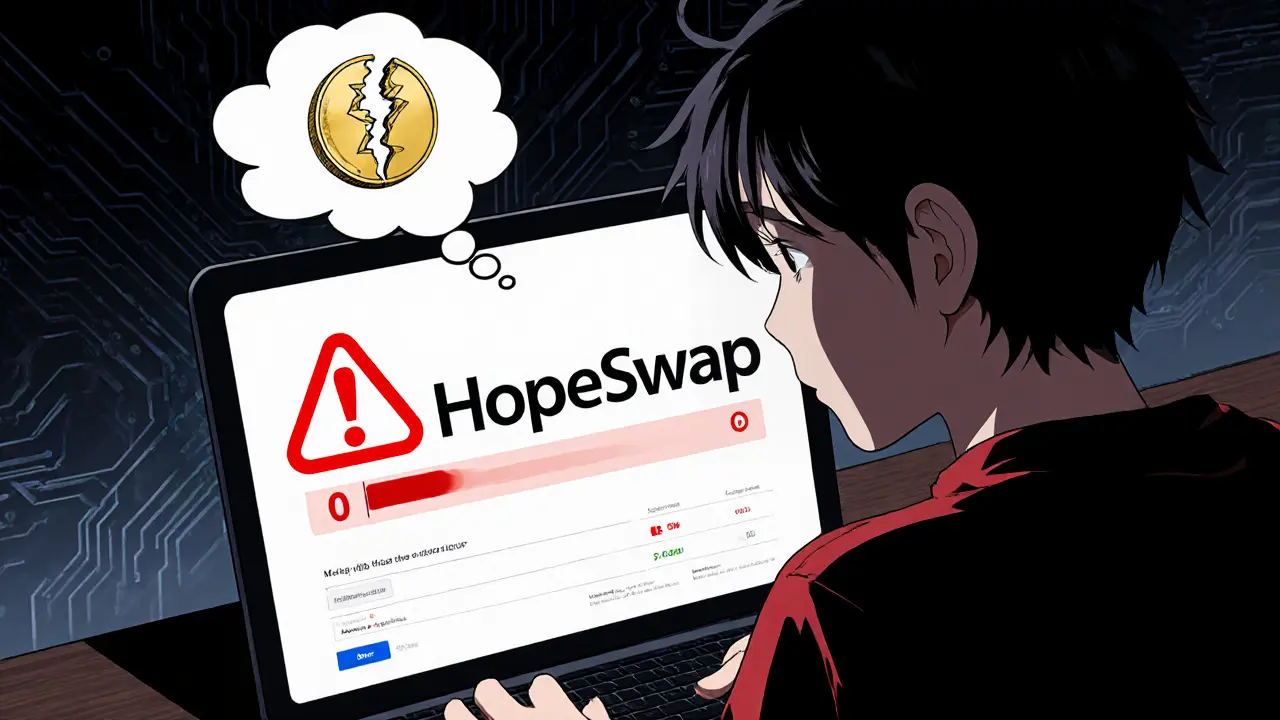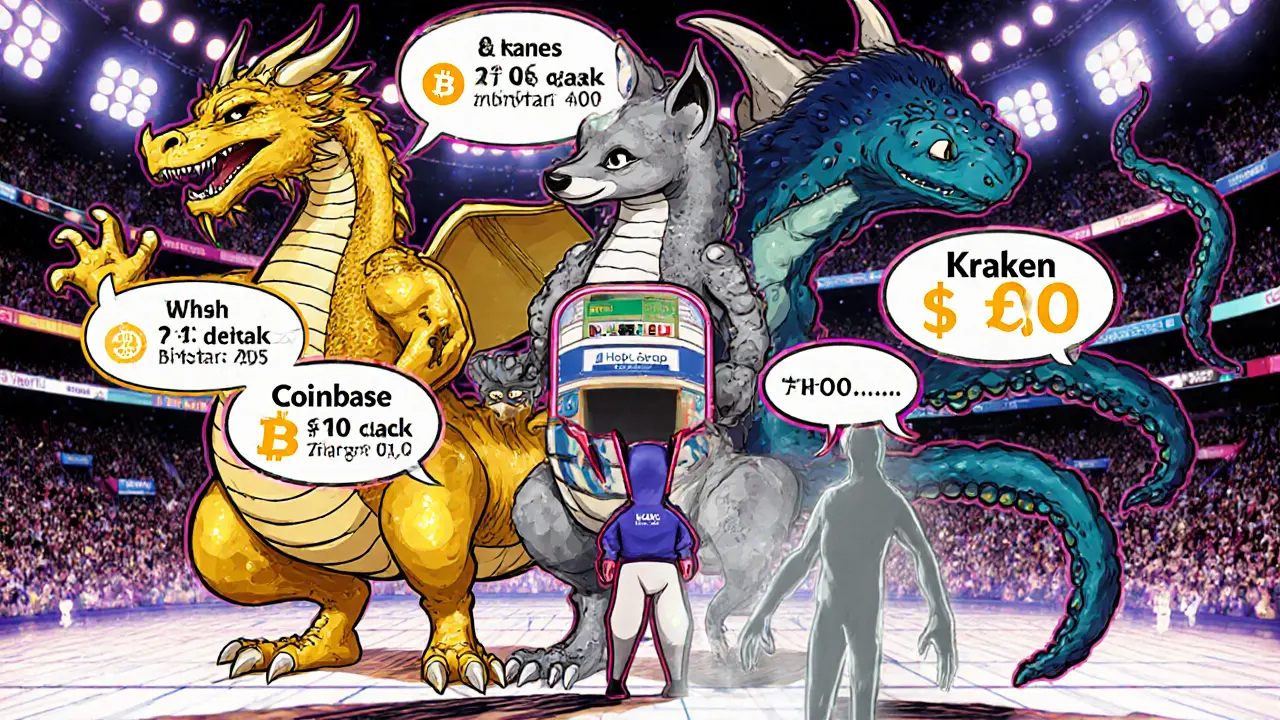HopeSwap Crypto Exchange Review: Risks, Reality, and Safer Alternatives

Crypto Exchange Risk Calculator
Exchange Risk Assessment Tool
Input key metrics to calculate a risk score based on industry standards. High risk indicators include trust scores below 3, zero trading volume, and lack of regulatory compliance.
Risk Assessment Results
Key Risk Factors
High risk indicators detected:
- Trust score below 3 indicates severe operational concerns
- Zero trading volume suggests liquidity crisis
- Missing security audits increases vulnerability to hacks
Recommendation: Avoid this exchange
Based on your inputs, this exchange fails to meet industry standards for security, compliance, and liquidity. The risk profile indicates a high probability of potential exit scam or operational failure.
Consider using established exchanges like Binance, Coinbase, or Kraken that meet all critical risk metrics.
If you’ve ever Googled HopeSwap crypto exchange review, you’re probably wondering whether this platform is a hidden gem or a risky gamble. The short answer: HopeSwap currently shows multiple red flags that make it unsuitable for most traders. Below we break down what the exchange is, why its metrics matter, how it stacks up against the big players, and what you should consider before putting any funds on the line.
What is HopeSwap?
HopeSwap is a non‑centralized cryptocurrency exchange launched in 2023 that markets itself as a low‑fee, community‑driven platform for digital assets. Unlike regulated giants, HopeSwap provides no public documentation on its technical infrastructure, security audits, or compliance procedures. The lack of transparent information makes it hard to gauge the safety of deposits or the reliability of trade execution.
Trust Score and Transparency
The most immediate indicator of an exchange’s reputation is its rating on independent platforms. CoinGecko is a leading cryptocurrency data aggregator that assigns trust scores to exchanges based on security, liquidity, and user feedback. As of the latest update in September2025, HopeSwap carries a trust score of0-the lowest possible rating on CoinGecko’s 10‑point scale. A zero score typically signals severe operational or security concerns, and many analysts advise avoiding any platform below a score of3.
Current Operational Status
Beyond ratings, real‑world activity tells the full story. HopeSwap reports zero active cryptocurrency pairs and has logged no transactions in the past 30days. Historical data indicates that the pair 0X9ED14/USDT was once listed as the most traded pair on the platform, yet this information now contradicts the platform’s dormant state. The absence of any trading volume suggests either a complete shutdown, a deep liquidity crisis, or a hidden exit‑scam scenario.
How HopeSwap Stacks Up Against the Industry Leaders
To put the numbers in perspective, here’s a quick comparison with three of the world’s most trusted exchanges. The table highlights key metrics that matter to everyday traders.
| Metric | HopeSwap | Binance | Coinbase | Kraken |
|---|---|---|---|---|
| Trust Score (CoinGecko) | 0 | 9.2 | 8.7 | 8.5 |
| Active Trading Pairs | 0 | 1,200+ | 600+ | 500+ |
| 24‑hr Volume (USD) | $0 | $12B | $4.5B | $1.9B |
| Liquidity Depth (Avg. Spread) | Not Available | 0.03% | 0.07% | 0.09% |
| Regulatory Compliance | None disclosed | Multiple licenses (US, EU, AU) | US and EU licenses | US, EU, Canada |
Even on a surface level, HopeSwap falls dramatically short across every category that seasoned traders consider non‑negotiable.

Red Flags: Security, Liquidity, and Compliance
When an exchange lacks basic operational data, three risk domains become immediate concerns:
- Security vulnerabilities: Without publicly audited code, third‑party security assessments, or a documented incident‑response plan, users cannot verify that their funds are protected against hacks or internal malfeasance.
- Liquidity shortages: Zero active pairs and zero recent volume mean there’s no market depth to execute trades at fair prices. Even a modest order could suffer massive slippage or fail entirely.
- Regulatory uncertainty: The exchange provides no evidence of KYC/AML procedures, licensing, or cooperation with financial authorities. In jurisdictions where crypto regulation is tightening, operating on an unregistered platform could expose users to legal scrutiny.
Industry best practices, as highlighted by security firms such as CipherTrace and regulatory bodies like the FCA, recommend steering clear of platforms that do not meet at least three of these standards.
Community and User Feedback - The Silence is Loud
Most reputable exchanges generate vibrant discussion threads on platforms like Reddit, BitcoinTalk, and Trustpilot. A quick search for “HopeSwap” on these sites returns practically no user reviews, support tickets, or community posts. This vacuum suggests either an extremely low adoption rate or a deliberately hidden user base. In contrast, exchanges like Binance and Coinbase have thousands of daily mentions, ranging from feature requests to bug reports, which helps users gauge real‑world performance.
Expert Opinions and Recommendations
Crypto analysts across major research firms consistently flag exchanges with trust scores below3 as high‑risk. For example, a 2024 report from Chainalysis listed HopeSwap among “potential exit‑scam candidates” due to its zero activity and lack of transparency. Security consultants advise allocating funds only to platforms that publish third‑party audit reports and maintain a proven track record of safeguarding assets.

Should You Trade on HopeSwap?
Given the current data, the prudent answer is no. The combination of a zero trust score, no active markets, absent community feedback, and no regulatory disclosures creates a perfect storm of risk. If you’re seeking a place to trade digital assets, consider alternatives that score high on security, liquidity, and compliance-such as Binance, Coinbase, or Kraken, all of which appear in the table above.
Should HopeSwap release a detailed roadmap, undergo a reputable security audit, and resume active trading with transparent fee structures, its risk profile could improve. Until then, treat it as an inactive or potentially defunct platform.
Quick Takeaways
- HopeSwap currently has a CoinGecko trust score of0 - the lowest possible rating.
- No active trading pairs or recent transaction volume as of September2025.
- Lacks public security audits, KYC/AML procedures, and regulatory licenses.
- Major exchanges (Binance, Coinbase, Kraken) outperform HopeSwap on every key metric.
- Experts recommend avoiding HopeSwap until it demonstrates transparent operations and active liquidity.
Frequently Asked Questions
Is HopeSwap still operational?
Current data shows zero trading activity and no recent transactions, indicating the platform is effectively dormant or possibly shut down.
What does a CoinGecko trust score of 0 mean?
A score of 0 reflects serious concerns about security, liquidity, and overall reliability. Most analysts consider any exchange below 3 to be high‑risk.
Are there any legitimate use cases for HopeSwap?
At present, no. Without active markets, transparent fees, or verified security measures, there’s no practical reason to deposit funds or trade on the platform.
How does HopeSwap compare to Binance in terms of fees?
Binance publishes a detailed fee schedule that starts at 0.10% for makers and 0.20% for takers. HopeSwap does not disclose any fee structure, making cost comparison impossible.
Should I keep my crypto on HopeSwap?
No. Moving assets to a well‑established exchange or a hardware wallet is the safest option given the lack of transparency and activity on HopeSwap.



Maureen Ruiz-Sundstrom
October 12, 2025 AT 04:13HopeSwap masquerades as a community‑driven platform, yet its silence screams of hollow ambition.
When an exchange offers no public audits, the only audit is the one performed by wary users who refuse to deposit their savings.
The zero trust score on CoinGecko is not a minor blemish; it is a categorical indictment of systemic failure.
Zero active pairs and a vanished 30‑day volume suggest not a temporary glitch but a structural desolation.
The absence of regulatory compliance transforms the platform into a legal terra‑nullius, a haven for illicit activity.
Philosophically, a market that refuses transparency violates the contract of mutual trust that underpins all exchange ecosystems.
Security is not an optional garnish; it is the foundation upon which any financial service must be built.
Without a published codebase or third‑party audit, users cannot discern whether the smart contracts are backdoors.
Liquidity is equally absent, meaning even a modest trade would likely trigger catastrophic slippage or outright failure.
The community‑driven narrative is a façade that masks an empty‑shell operation.
In the grander schema of decentralized finance, HopeSwap functions as a cautionary tale rather than a beacon of innovation.
Its dormancy is not merely a pause but a symptom of an entity that failed to attract genuine participation.
Investors should heed the principle that a platform which cannot prove its existence should not hold their assets.
Until a reputable audit, clear KYC/AML procedures, and active market making are demonstrated, the platform remains a speculative void.
In other words, steer clear, protect your capital, and allocate resources to exchanges with demonstrable integrity.
Kevin Duffy
October 26, 2025 AT 01:33Thanks for the thorough breakdown! 🙌 Definitely keeping my funds away from HopeSwap. 🚀
Kim Evans
November 8, 2025 AT 22:53For anyone still contemplating HopeSwap, consider the practical alternatives.
Binance, Coinbase, and Kraken all publish their audit reports and maintain active liquidity pools.
Moving assets to a platform with verifiable security measures reduces exposure to exit‑scams.
If you need a quick move, a hardware wallet is also a solid fallback.
Steve Cabe
November 22, 2025 AT 20:13While the post paints HopeSwap as a dead horse, the reality is that American traders need robust, domestically‑regulated venues.
Zero transparency is intolerable for any exchange serving U.S. users.
Until an American regulatory body certifies its operations, we should treat it as a no‑go.
shirley morales
December 6, 2025 AT 17:33Nice effort but the facts speak for themselves.